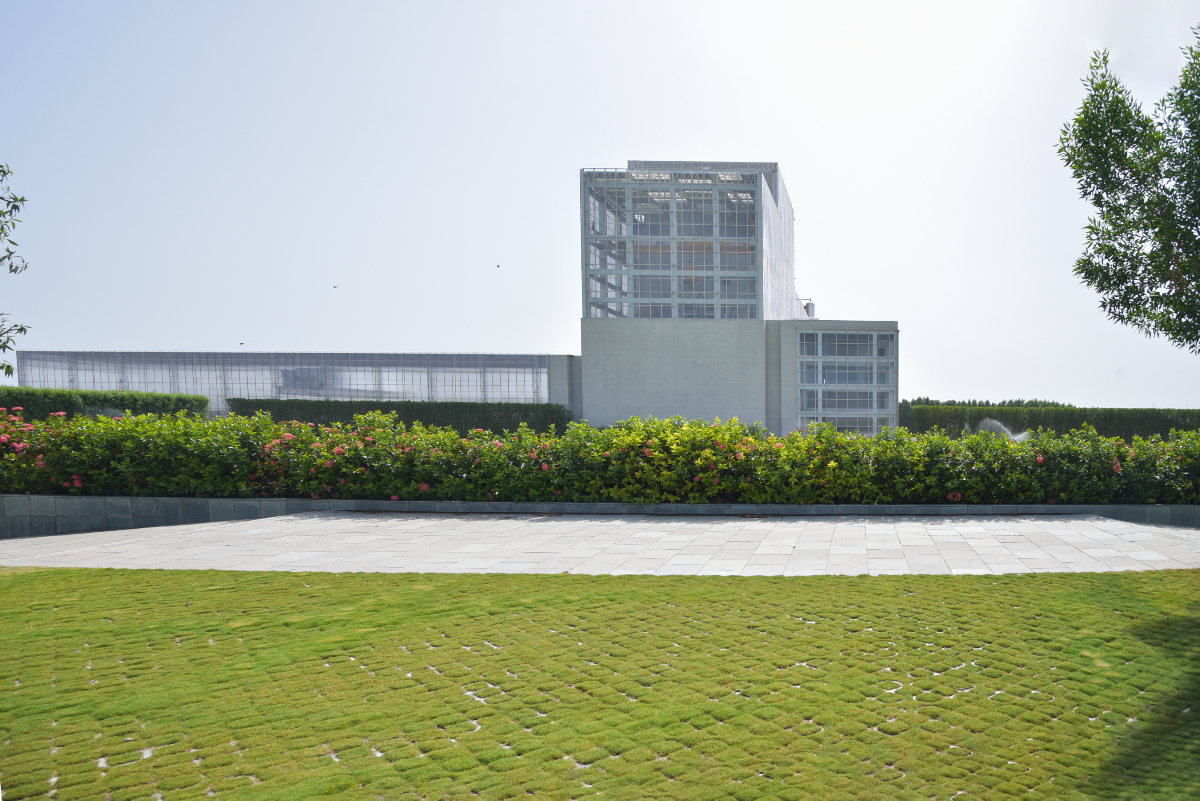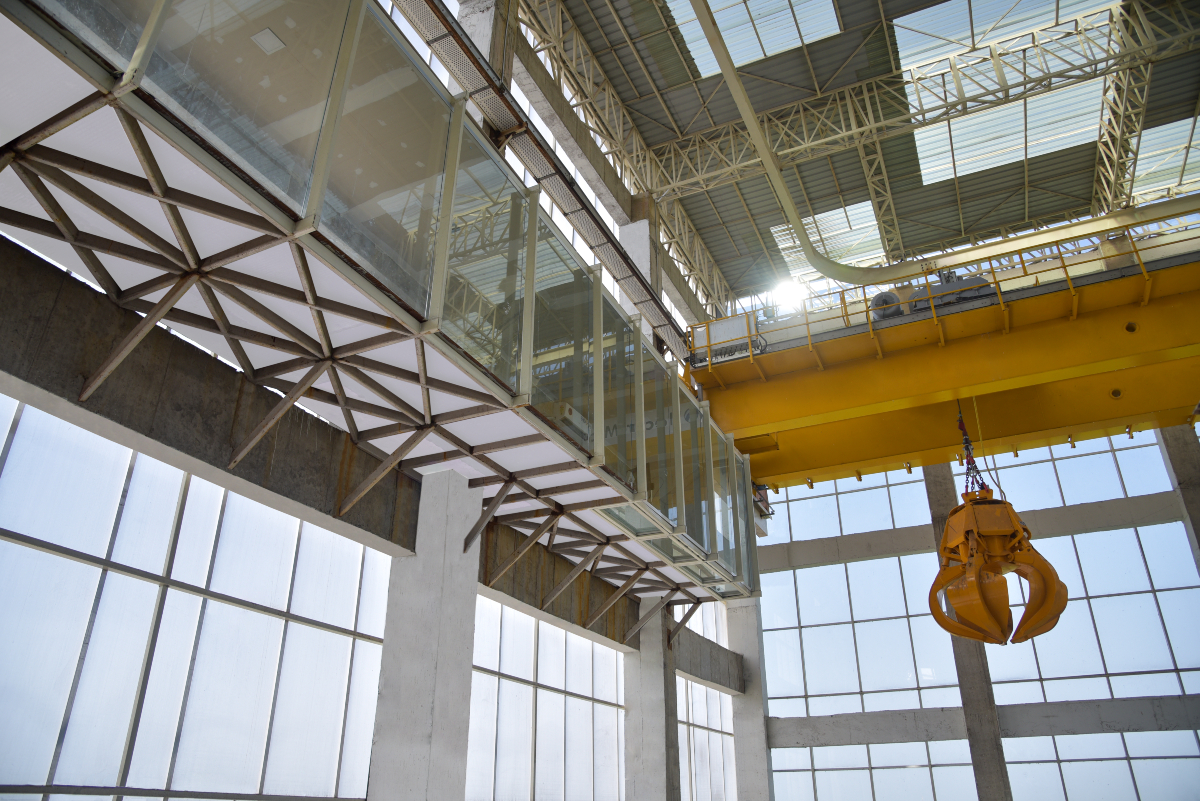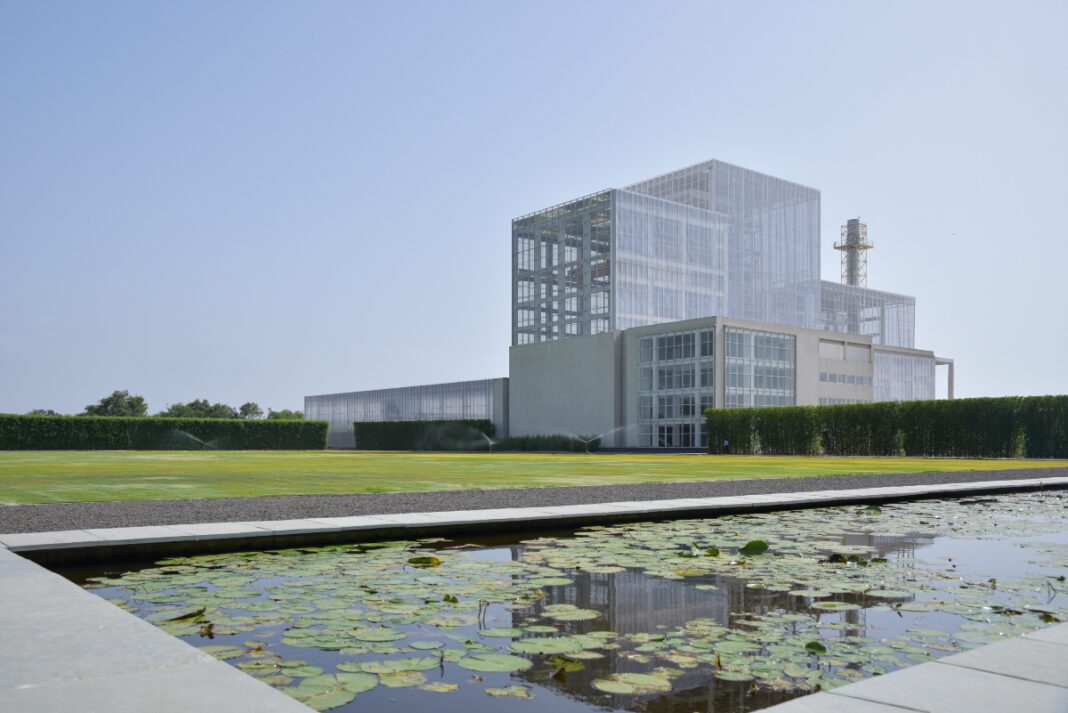The Abellon Waste-to-Energy campus exemplifies a holistic design approach that addresses technological and environmental needs. Evolving from a simple client brief, the campus processes MSW, generates clean energy and spreads awareness about waste management while showcasing responsible industrial practices for net-zero development. Sustainability is central to this design, featuring renewable energy use, energy-efficient systems, and natural resource optimisation, with strategies like natural ventilation, daylighting, solar panels, and decentralised waste treatment systems.
The main plant generates power from municipal waste, biogas, solar energy, and biomass, with features like an electric car charging station and an eco-stove. Renewable energy systems serve as educational touchpoints for visitors, while the Neem ‘van’ hosts exhibitions and fairs. The campus includes sports grounds, a jogging track, and venues for cultural events. Kalpavruksh Vatika supports yoga, meditation, and plantation drives, and misting fountains enhance BOD levels and host light shows. Aeroponics vertical farming and an art wall made from MSW promote sustainable agriculture and waste management awareness.
Jayesh Hariyani, Chairman and Managing Director of INI Design Studio, highlights how the plant’s Vastu-guided layout fosters positive energy, enhances productivity, ensures efficient waste flow, and meets strict regulations.

Circular Solutions
The campus integrates urban waste treatment with functional, sustainable, and socially responsible infrastructure. Its modular layout efficiently handles diverse waste streams, including organic, non-organic, and hazardous materials, while allowing for future technological upgrades or scaling. Advanced systems like automated segregation, moisture control, and high-efficiency incinerators optimise waste flow through sorting, decomposition, and energy recovery processes.
Closed-loop operations extract valuable resources such as biogas, plastics, and ash for reuse, promoting a circular economy. Passive design features like natural ventilation, daylighting, and thermal insulation complement active systems like solar panels and advanced heat recovery mechanisms, significantly reducing the environmental footprint. Landscaping with native, drought-resistant plants and rainwater harvesting further enhances sustainability by minimising water consumption and recharging groundwater.
Steel was chosen for the campus due to its strength, versatility, and efficiency in construction. Its durability ensures resilience to harsh environmental conditions typical of waste processing sites, while its design flexibility enables the creation of large, open spaces required for waste processing equipment. Prefabricated recycled steel structures follow the principle of “form follows function,” optimising process flow through vertical stacking and equipment sizing.

These lightweight structures minimise resource consumption and reduce construction time. Additionally, translucent, multilayered polycarbonate facades enhance thermal performance and reduce operational costs. Polycarbonate panels allow ample natural light to permeate interiors, cutting down on artificial lighting needs during the day, while their lightweight, impact-resistant design facilitates easy installation and reconfiguration.
The campus design incorporates Vastu principles, with administrative and community spaces positioned in the northern and eastern zones to harness positive energy and create a welcoming atmosphere. Treatment units are strategically placed in the southern and western zones to mitigate noise and odours, ensuring operational efficiency and user comfort.
Open spaces, water bodies, and green zones act as natural buffers, reducing noise and air pollution while fostering a healthier work environment. The site’s orientation optimises sunlight and ventilation, minimising heat gain and reliance on artificial systems.
Community Driven
The project, a PPP model between Goodwatts WtE Jamnagar Pvt Ltd (GWJPL) and Jamnagar Municipal Corporation (JMC), transformed a barren wasteland into a sustainable ecological hub. Previously used for unmanaged waste dumping, and contaminated by heavy metal leachate, the site was remediated through soil treatment, landscape planning, and irrigation management. Addressing the unpredictable nature of Indian urban waste, the project implemented modular waste treatment systems, moisture control mechanisms, and scalable designs to ensure efficient processing and continuous energy generation.

The campus design emphasises sustainability, functionality, and adaptability, with a lightweight, open-span prefab steel structure that optimises operational efficiency through vertical stacking and compact equipment sizing. A modular facade system of translucent layered polycarbonate panels blocks UV radiation while allowing filtered daylight to permeate, reducing lighting energy consumption by 60 per cent. Detailed energy modelling demonstrated a 92 per cent reduction in lighting power through LED improvements. With only 20 per cent of the site dedicated to plant operations, the design reserves space for community areas, green zones, and future expansion, fostering long-term sustainability.
Community engagement was central to the project’s success, beginning with a three-day workshop at Abellon’s Ahmedabad headquarters, where inputs from government officials, social leaders, and architects were integrated into the design process. A comprehensive Environmental Impact Assessment (EIA) guided the adoption of mitigation measures such as air and water quality monitoring systems, dust suppression techniques, and emission controls.
Transparent communication with local communities addressed concerns about noise, emissions, and health impacts, fostering trust. Thoughtful landscaping and material selection allowed the campus to blend seamlessly into its surroundings, transforming the site into a vibrant community hub that hosts events, sports, and educational programs while showcasing cutting-edge waste management technologies.

Green & Growing
The Abellon WTE campus exemplifies sustainable land use and advanced waste-to-energy practices by dedicating only 20 per cent of its site to plant operations, reserving the rest for green zones, community spaces, and future expansion. Segregated entry points enhance efficiency and safety, while native plantations, orchards, and misting ponds mitigate the urban heat island effect and support biodiversity.
The facility thermally processes 220,000 tonne of municipal solid waste (MSW) annually, generating 43.75 million units of green power and preventing 37,317 MT of CO2 emissions. A multi-stage flue gas cleaning system ensures compliance with global and local emission standards, while an onsite 7.5 kW solar PV system and biogas plant meet 100 per cent of its electricity needs. Treated municipal wastewater is used for cooling, reducing freshwater demand and power consumption through an AI-supported system that optimises temperature control.
 Fostering a circular economy, the plant processes non-recyclable plastics and 1 MLD of treated sewage water, preventing 22,000 tonne of ocean-bound plastic pollution. Its integrated value chains include bioCNG production, plastic recovery, and green chemical manufacturing. Patented technology tailored for Indian urban waste conserves 50 acre over 20 years, while fly ash is repurposed into construction blocks and pavers, and recovered plastics are used in building materials. By reducing landfill dependency and reintegrating valuable resources into the economy, the Abellon WTE campus sets a benchmark for sustainable infrastructure, contributing to environmental stewardship and economic resilience.
Fostering a circular economy, the plant processes non-recyclable plastics and 1 MLD of treated sewage water, preventing 22,000 tonne of ocean-bound plastic pollution. Its integrated value chains include bioCNG production, plastic recovery, and green chemical manufacturing. Patented technology tailored for Indian urban waste conserves 50 acre over 20 years, while fly ash is repurposed into construction blocks and pavers, and recovered plastics are used in building materials. By reducing landfill dependency and reintegrating valuable resources into the economy, the Abellon WTE campus sets a benchmark for sustainable infrastructure, contributing to environmental stewardship and economic resilience.
Fact File
Project: Abellon Waste To Energy (WTE) Campus, Jamnagar
Client: Goodswatts WTE Jamnagar Private Limited (SPV Abellon Clean Energy Group)
Architect & Project Management: INI Design Studio
Structural Consultant: DELF Consulting Engineers (India) Pvt Ltd
Fabricator: Sai Nath Fabricator
Supplier: TATA Steel
Tonnage: 150 tonne
Status: Completed
Quote
“The Abellon Waste-to-Energy campus is a pioneering project that incorporates innovative design, sustainable practices, and cutting-edge technologies to tackle urban waste management and energy generation challenges. By balancing environmental, social, and economic needs, it sets a benchmark for future waste solutions through waste-to-energy systems, modular processing units, and community infrastructure.”
– Jayesh Hariyani, Chairman and Managing Director, INI Design Studio
– Vanshika Raigaga





